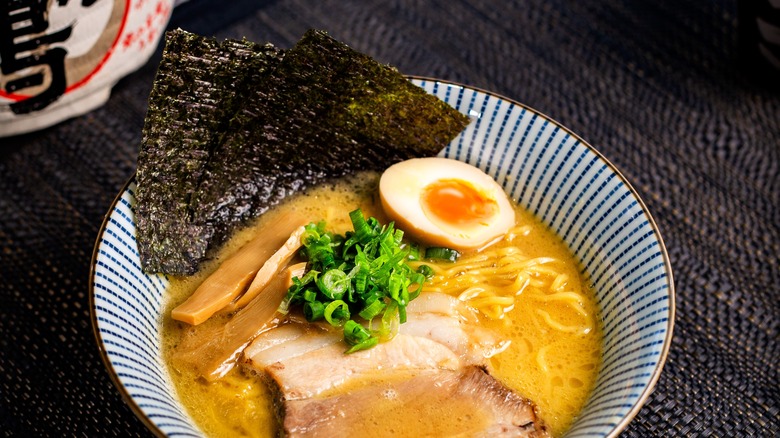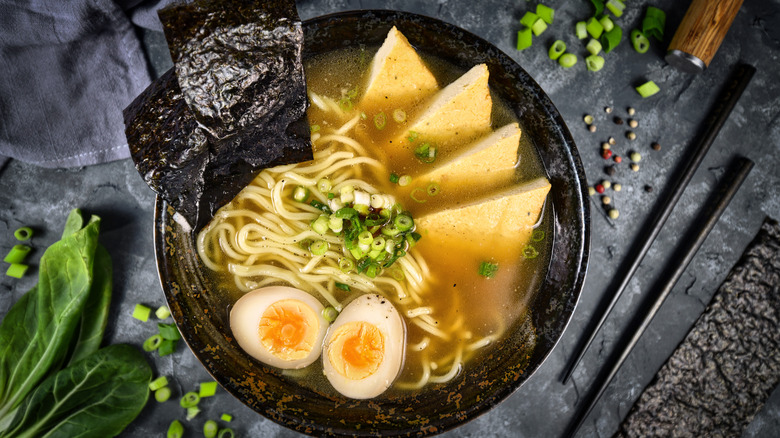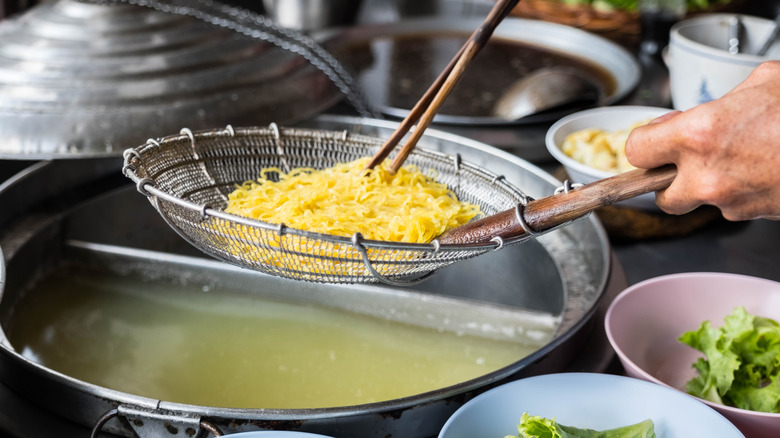The Simple Seasoning Used For Flavorful Ramen Dishes
If the only ramen you've ever had has come from a plastic package, then let me be the latest person to tell you that you are missing out. A finely made bowl of ramen noodles with all its assorted fixings makes for a gorgeously satisfying meal. In this modern era, you don't even need to go to Japan to get a delicious bowl of noodles as great ramen shops are scattered across the United States.
Ramen Yokocho claims that the first bowls of noodles served in broth originated in 19th-century China, and it spread to the Japanese islands with Chinese immigrants. Although proper ramen wasn't actually invented until the '40s, it didn't take long for word of the dish's benefits to spread, and it subsequently became immensely popular in both its artisan and instant forms. Of course, even if you've only ever had the instant edition, you probably have a pretty good idea about why it's so popular.
Air Kitchen says that the secret to ramen's popularity is obvious to anyone who has ever warmed themselves up with a steaming bowl of noodles on a cold day. The many complex flavors of good ramen are instantly satisfying. Ramen's lack of rigid rules also allows consumers to customize and upgrade ramen any way they'd like. The secret to this meal's flavor actually lies in one special component known as a tare (pronounced tah-ray).
What is tare?
According to Culinary Crush, tare is the Japanese word for sauce. This can be slightly confusing because the tare isn't what most Americans would really consider a sauce. Instead, it's the well-protected blend of seasonings and flavors that gives a bowl of ramen most of its flavor.
Food and Meal says that the tare is kept separate from the broth to easily mix up different flavors of soup with different meat broths. The three most common types of tare are shio (salt), shoyu (soy sauce), and miso. While these give a general sense of the flavor and colors to expect from these tare, there are no guidelines for what makes a good tare. Like most things when it comes to food, it all just comes down to personal taste.
Culinary Crush claims that tare makes up about one-tenth of the final broth. Its flavors are highly concentrated though and make up for many of a soup's notable flavors. If you've ever tried to follow a recipe for ramen broth at home and were left disappointed by the results, it's likely because that recipe left out the tare. Needless to say, tares are highly protected recipes because they can be the difference maker between an elite ramen shop and something more subpar.
How to make a ramen tare
Culinary Crush points out that there are no guidelines as to what makes a good tare. The more important role of the tare is to fill out the flavors present in the broth. This could mean having a higher concentration of salt, adding mirin for sweetness, or adding notes of seafood with dried kombu or bonito flakes. Spices like ginger, garlic, and mushrooms can all be added as well. It all depends on personal tastes, complementing flavors, and crafting a balanced complexity in the broth.
Ramen Chemistry adds that it's important to remember the tare is there to elevate the soup. While these flavors are highly important, they shouldn't be the focal point of the ramen. A tare used for a tonkotsu ramen, for example, should be building on and developing the flavor notes already present in the pork broth without trying to outshine them. For this reason, the best way to make a tare is to experiment and play with flavors. Look at other tare recipes and components, and try to create something that you would want to add to your favorite broth.


